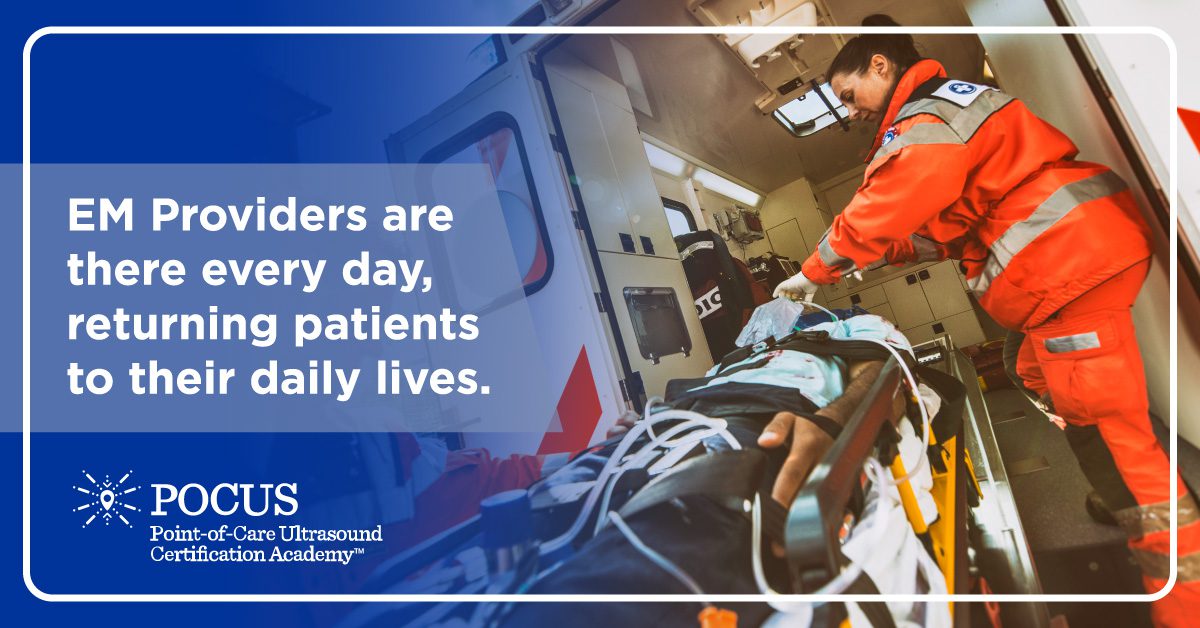Imagine going from doing the everyday tasks—walking the dog, dressing for work or school, eating a meal—to encountering a life-threatening ordeal that no one could predict. Emergency departments are filled with patients who arrive in terror and concern from the turn of events they now face. Uncertain and unfamiliar with the steps required to return to the routine of what they call life, they deliver an SOS to those who can rescue them in their time of need.

This frantic tone is the frequent state of mind of the patients, medical providers in emergency medicine (EM) tend to. It is a specialty dedicated to the diagnosis and treatment of unforeseen illnesses or injuries. The American College of Emergency Physicians describes emergency medicine as a field that incorporates “the initial evaluation, diagnosis, treatment, coordination of care among multiple clinicians or community resources, and disposition of any patient requiring expeditious medical, surgical, or psychiatric care.”
Emergency healthcare professionals are the very fabric of medicine in the U.S. The planning, management, and execution of medical control and disaster preparedness rest on their shoulders. This group of dynamic providers contributes immeasurable clinical, administrative, and leadership services to the healthcare system. Due to the immense responsibility of emergency care professionals, possessing incredible knowledge and understanding of the various disciplines within medicine is a must.
Undoubtedly, this is one specialization constantly under intense, high-pressure circumstances, yet, they always bring their patients the best of themselves. That is why on May 27th, we pause to celebrate #EmergencyMedicineDay. This year’s event theme: We Are Always There For You—a narrative that never rang more true proceeding a year where the entire globe leaned heavily on EM providers to see us through.
Launched by the European Society for Emergency Medicine (EUSEM), International Emergency Medicine Day (EM-Day) is in its fourth year promoting and raising awareness worldwide of the impact and vitality of a strong, prevailing emergency healthcare system. Unlike any other time before, the EM-Day message needs to resound in every sphere of the globe.
Year four stands apart from the years preceding. It comes off the tail end of the introduction of a new pandemic that lingers still. COVID-19 has unearthed and made a stronger case for an accessible EM system supported by the medical community and patients alike. It is essential for facing all the challenges of the pandemic and the numerous other unpredictable trauma forced to grapple with. On May 27th, we can rally around a sector of our community that actively takes on the unknown, unplanned, and unforeseen elements of healthcare.
Being prepared for anything is not an easy feat to master. Yet, these highly skilled professionals do so day in and day out. The EM discipline relies on highly trained and certified providers to accomplish this extraordinary level of preparedness. Additionally, their primary role involves resuscitating and stabilizing patients to transition care to the appropriate endpoint—the ICU, inpatient bed, another provider or hospital, or home.
Emergency physicians evaluate a broad assortment of ailments, many times with little to no information. They must think and act quickly to make a provisional diagnosis and determine the appropriate course of treatment. Time is usually of the essence when working in an emergency. Systems such as seamless registration that benefits a patient’s clinical progress, evaluation modalities like point-of-care ultrasound, which provide rapid medical evaluations in triage, directing patients to the appropriate care settings, and an established triage process are all critical in preserving time and aiding EM providers in their life-saving quest.
A Call to the People to Support Emergency Medicine
So how do we come behind our peers in EM? EUSEM has created a social campaign for all to join in. Share your emergency department story in three easy steps.
- Upload a picture
- Write your story
- Generate a shareable post for your social channels
See who has already supported this cause by visiting EUSEM’s Emergency Medicine Day’s gallery.
Remember, if there is one specialty among our community that is always there, it’s our EM peers. They are there every day, returning patients to their daily lives.
EVEN WHEN IT’S IN THE MIDDLE OF THE NIGHT
EVEN WHEN IT’S A HOLIDAY
EVEN HIDDEN BEHIND A MASK
24/7/365, EM PROVIDERS ARE HERE!





















